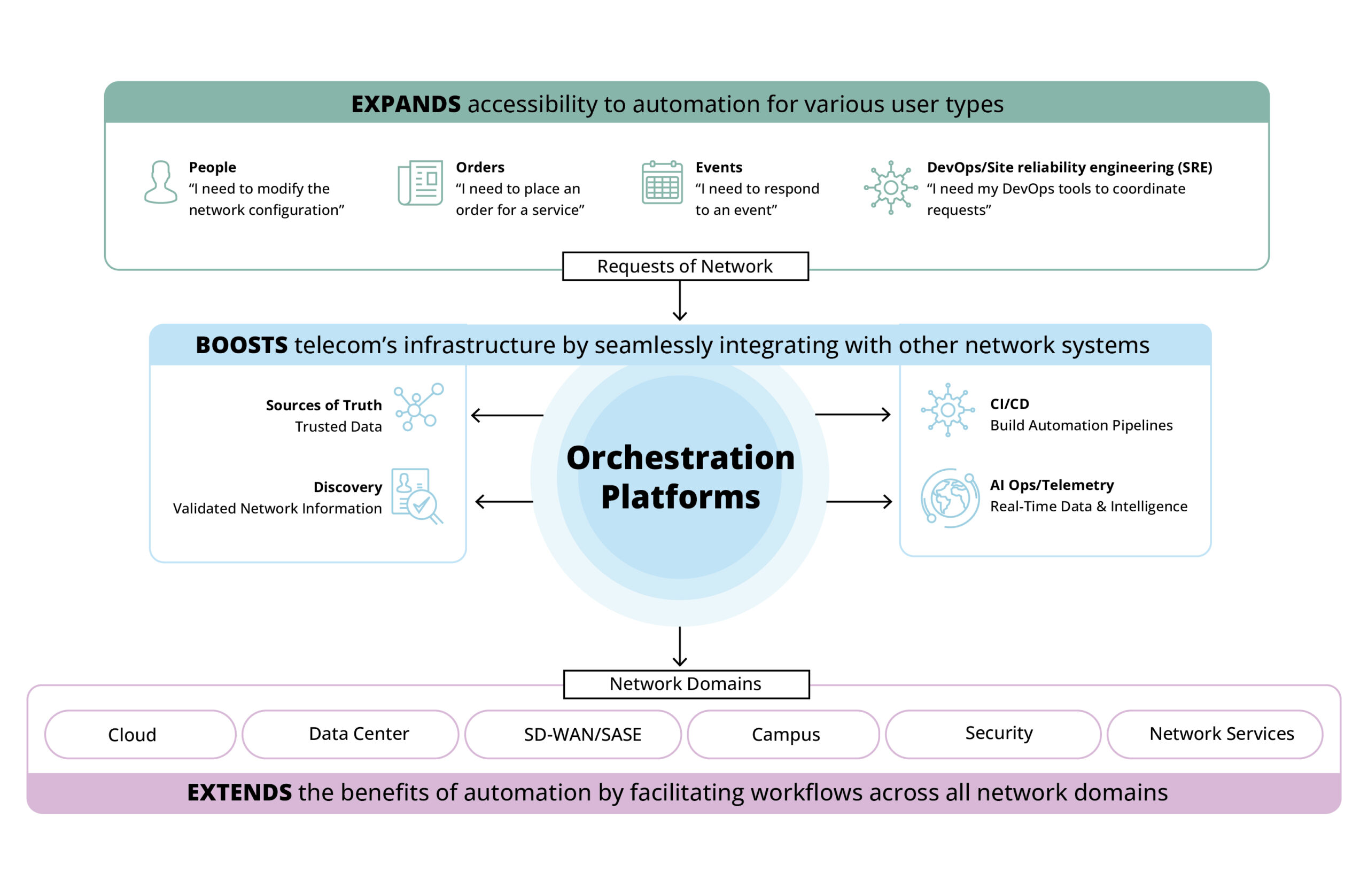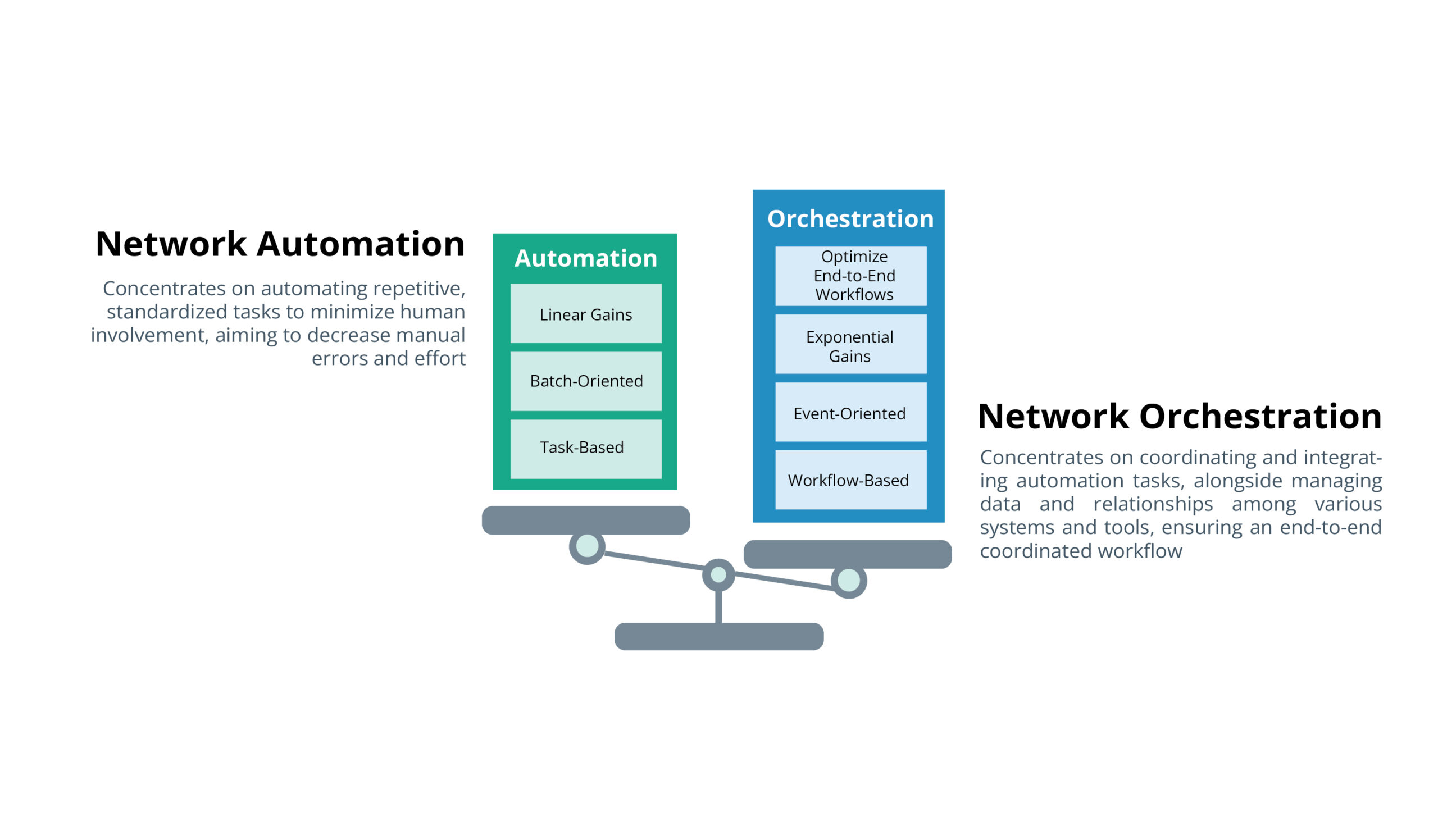You could miss a great opportunity if you have not embraced network orchestration yet. Since network connectivity is a king of telecom services, optimizing it could yield significant financial benefits. However, IT service costs soar due to inflation, so finding ways to streamline budgets becomes imperative. But what if there was a solution that helps cut costs and enhances network performance?
Enter network orchestration – a strategic tool that boosts efficiency and prepares your telecom organization for future advancements. Let’s delve into the concept of network service orchestration and explore its efficiency-boosting capabilities for telecoms.
What is network orchestration?
Just like a conductor guiding an orchestra to create melodies, network orchestration empowers telcos to navigate the complexities of network configuration, deployment, and security challenges. Network service orchestration efficiently coordinates various network interactions involving people, devices, and systems, ensuring optimal security, efficiency, and effectiveness in telecom operations.
The advantages of network orchestration are universal, but particularly impactful in the telecom sector, helping to focus on intricate issues, enhancing overall productivity. Additionally, network automation and orchestration enable rapid scalability of solutions, providing telecoms with a competitive advantage.
Why do you need network orchestration?
With the rapid growth of data and devices, manual approaches are becoming increasingly untenable. Surprisingly, despite this trend, Cisco reports that up to 95 percent of network modifications are still executed manually, leading to operational expenses that are two to three times higher than the network costs. Telecoms must prioritize increased automation, centrally and remotely managed, to keep pace with evolving demands effectively. Explore the significant challenges that telcos are facing in the infographic below:

Types of network orchestration
The choice of orchestration type depends on your enterprise’s specific needs. These versatile options make network orchestration adaptable to various environments, from traditional on-premises setups to expansive cloud deployments. With network orchestration, IT teams can enhance IoT and SD-WAN deployments, manage service life cycles across multiple operators, and monitor service level agreements effectively.
In essence, network orchestration comes in three main forms:
Policy-based automation (PBA):
PBA simplifies management by controlling device policies rather than individual parameters. These policies, applied to specific device types or roles, organize devices and services into logical groups aligned with business functions. These logical groups can be easily replicated across devices or systems, making it efficient to implement changes and templates, especially through GUI (graphical user interface) dashboards.
Software-defined networking (SDN):
SDN introduces software-based controllers or APIs for programmatic management of network functions like provisioning and monitoring. Unlike PBA, SDN allows direct programmability and separates application and controller layers, providing flexibility and real-time network edits. With centralized network intelligence, SDN simplifies design and promotes vendor-agnostic solutions, leveraging virtualization and software for dynamic ecosystems.
Intent-based networking systems (IBNS):
IBNS employs AI to optimize the network based on human-defined intents rather than manual coding. Network administrators set outcomes or business objectives, and AI-driven machine learning optimizes the network accordingly by establishing routines, policies, and responses to system events. While IBNS automates much of the technical work and allows human tweaks to ML algorithms for efficiency, it relies on the speed of ML milestones achievement, which may take time depending on the intent.
How does network orchestration work and who needs it?
In general, network orchestration involves collaboration between network controllers and programmable network devices to execute tasks efficiently. A network controller possesses a comprehensive overall picture of the entire network, covering its configuration, architecture, infrastructure components, users, devices, and traffic patterns.
However, changes in business objectives may necessitate swift modifications within the network. Network orchestration enables the network controller to swiftly implement, verify, and manage these updates. For instance, when adding a new user to the network, the orchestration platform ensures accurate configuration settings, proper authentication, and appropriate access levels. Network service orchestration also adjusts settings for switches, routers, firewalls, and servers as needed, upholding security protocols across all network devices.
Typically, organizations with 250 or more employees and over 20 network devices can gain significant advantages from employing an orchestration platform. This includes companies deploying hundreds of IoT devices, where network orchestration ensures seamless configuration and swift adjustments during deployment, ensuring smooth data transmission to designated systems.
What are the benefits of network orchestration?
Network service orchestration brings multiple benefits for telecoms but let us focus on three main advantages first. The infographic below illustrates the typical network orchestration workflow for a CSP provider.

Network orchestration platforms bring three main advantages to telecoms: expanding automation, boosting infrastructure, and extending the benefits pf automation across all network domains
- Expanding accessibility to automation for various user types, spanning events, order systems, and CI/CD pipelines.
- Boosting infrastructure by seamlessly integrating with other network systems, such as monitoring systems and AIOps (Artificial intelligence operations), facilitating the provision and dissemination of accurate information.
- Extending the benefits of automation by facilitating workflows across all network domains and leveraging and optimizing existing automation assets like Python scripts or Ansible Playbooks. At the business level, these three advantages of efficient network orchestration drop down into the following benefits:
- Minimizing human error by mitigating human error, including redundancies and effective monitoring to catch and rectify mistakes swiftly.
- Instant, secure connectivity enabled via seamless connection to company resources at new sites with just an internet connection, saving time, energy, and resources.
- Streamlined issue resolution by consolidating network state, configurations, logs, and statistics, facilitating faster troubleshooting and adjustments.
- Scalability with APIs: API-driven orchestration services enable dynamic scalability, allowing businesses to adapt to traffic changes or user demands promptly.
- Tooling opportunities through facilitating the integration of third-party and custom tools, enhancing network insight, and addressing performance issues effectively.
- Simplified data management via automated data usage monitoring prevents additional costs from exceeding wireless plan limits and enables IT teams to identify heavy users effortlessly.
Network orchestration vs network automation vs network management
For some time, “network automation” and “network orchestration” have been used interchangeably in our industry. However, these terms are two separate but closely related concepts. Understanding these differences and knowing when and how to use them is crucial for revolutionizing how your network infrastructure is managed and utilized in support of agile operations. Successful adoption of both automation and orchestration can greatly speed up IT processes across intricate infrastructure environments.

Source: 2023 Gartner® Market Guide for Network Automation Platforms
You might also hear “network management” term. In general, network management involves administering and operating networks. Typically, a central network management system, often the network controller, utilizes its automation and orchestration capabilities for these tasks. In essence, network orchestration falls under the umbrella of network management.
The Intellias method: Ensuring scalability with private 5G network Orchestration
Transitioning from proof of concept to a market-ready platform tailored for private 5G networks posed a significant challenge for our client. To accelerate progress, the Intellias team deployed skilled developers to deliver the client’s innovative automation and orchestration platform swiftly.

The custom-built automation and orchestration platform for private 5G networks, developed for our client, is adaptable for diverse enterprise and industrial applications
Speed was paramount for validating the client’s visionary concept and establishing their leadership in the dynamic telecommunications and network infrastructure sector. Through streamlined processes and cutting-edge technologies, we enabled our client to navigate the evolving telecommunications landscape with confidence, emerging as a trailblazer in private 5G networks.
Are you ready for your path forward?
From concept to market-ready platforms specializing in private 5G networks, our skilled developers ensure swift delivery and seamless integration with your backend systems. Don’t miss the opportunity to streamline your network operations and position your company as a leader in the telecommunications landscape. Explore the possibilities with Intellias today!
With Intellias by your side, you can confidently navigate the complexities of network orchestration, accelerate innovation, and emerge as a pioneer in telecommunications.




